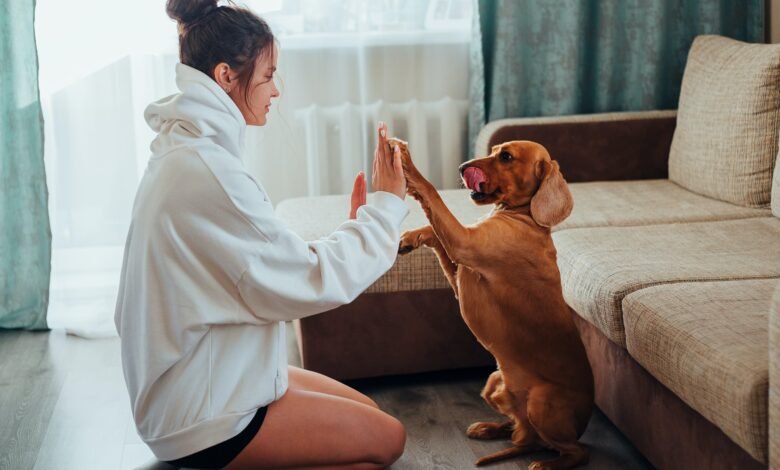Building a Strong Bond: How Training Strengthens the Relationship with Your Dog

Building a strong bond with your furry companion is a journey that goes beyond mere companionship. It’s about understanding their world and creating a language of love and trust. One of the most effective ways to achieve this is through training.
Understanding Your Dog’s Perspective
Dogs communicate through body language and respond to the world based on instinct. Understanding their perspective is crucial for effective training. As an owner, recognizing the cues and signals your dog provides builds a bridge of understanding.
Positive Reinforcement in Training
Positive reinforcement is the cornerstone of successful training. By rewarding desired behaviors with treats, praise, or play, you create a positive association. This not only encourages obedience but also nurtures a sense of trust and confidence between you and your dog.
Basic Obedience Training
Basic obedience training lays the foundation for effective communication between you and your dog. Commands such as sit, stay, and come are not just about control but also about building trust. The more your dog understands and follows your commands, the stronger the bond becomes.
5. Advanced Training Techniques
Moving beyond basic commands, advanced training techniques, such as tricks and agility training, inject an element of fun and mental stimulation into your relationship. Dogs thrive on challenges, and advanced training provides an avenue for shared accomplishment.
6. Training as a Two-Way Street
Training is not just about instructing your dog—it’s a collaborative effort. As you teach, you also learn more about your dog’s unique personality and quirks. This two-way street of communication forms the basis of a partnership built on mutual understanding.
7. Overcoming Training Challenges
Challenges in training are inevitable, but they are also opportunities for growth. Patience and consistency are key. Whether it’s overcoming stubbornness or addressing fear-based behaviors, tackling challenges together strengthens the bond.
8. Training Through Life Stages
Tailoring training to different life stages is essential for ongoing development. From the exuberance of puppyhood to the wisdom of senior years, adjusting your training approach ensures a strong bond throughout your dog’s life.
9. The Role of Play in Building Bonds
Incorporating play into training sessions enhances the bonding experience. Play is not just a reward; it’s a shared activity that deepens your connection. A joyful, playful atmosphere during training reinforces the positive association with learning.
10. Training Beyond Commands
Behavioral training goes beyond basic commands, addressing specific issues like aggression, fear, or excessive barking. By focusing on behavioral aspects, you create a well-rounded and well-behaved companion.
11. The Connection Between Routine and Bonding
Establishing a routine provides predictability for your dog, creating a sense of security. The consistent structure of a routine enhances the training process, making your dog more receptive to learning and strengthening the bond through shared activities.
12. Celebrating Achievements Together
Every successful training session is a milestone worth celebrating. Whether it’s mastering a new trick or overcoming a behavioral challenge, acknowledging these achievements together builds a sense of accomplishment and shared joy.
13. The Emotional Aspect of Training
Training is not just a mechanical exercise—it’s an emotional journey. The time spent together during training creates a unique emotional bond, fostering a connection that goes beyond the physical act of teaching commands.
14. Building Trust Through Training
Trust is the bedrock of any strong relationship. Through consistent and positive training, you establish trust with your dog. Knowing that they can rely on you for guidance and support deepens the bond and solidifies your role as their leader.
15. Conclusion
In conclusion, training is more than just a means to an end. It’s a dynamic process that shapes the relationship between you and your dog. From basic obedience to advanced tricks, each training session is an opportunity to reinforce your bond and create a lifelong connection.
Frequently Asked Questions (FAQs)
- How long does it take to see results from training?
- The timeframe varies based on the dog’s temperament and the complexity of the training. Consistency is crucial, and patience will yield positive results over time.
- Can older dogs learn new tricks?
- Absolutely! While younger dogs might catch on faster, older dogs can learn new tricks with patience and positive reinforcement.
- What if my dog seems uninterested in training?
- Assess the training environment, use high-value treats, and make sessions more engaging. Adjust the approach to match your dog’s enthusiasm.
- Is professional training necessary, or can I train my dog at home?
- While professional trainers can be beneficial, many owners successfully train their dogs at home with patience, consistency, and positive reinforcement.
- How often should I train my dog for optimal results?
- Short, regular sessions are more effective than infrequent, lengthy ones. Aim for 5-10 minute sessions a few times a week to keep your dog engaged and motivated.




